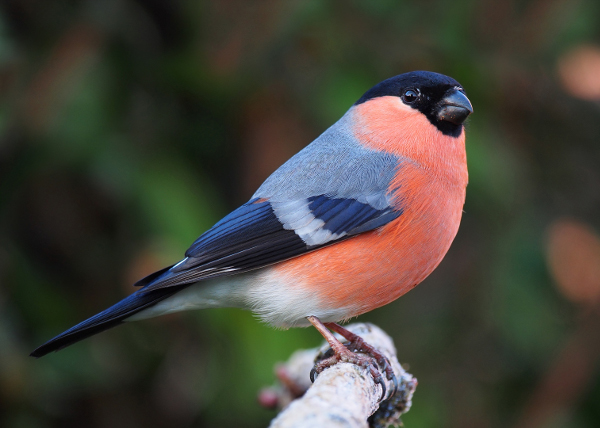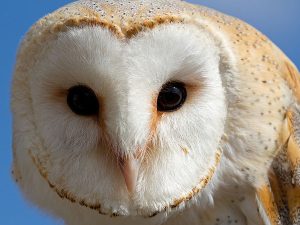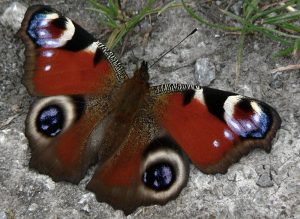Living in a cool and slightly windswept location in the South Shropshire Hills means that the arrival of migrant birds or the appearance of the first spring butterflies occurs a little later here than it does in counties further south and east. These wildlife events are very weather dependent too, so we are now used to the appearance of butterflies in our garden rather later in spring than it was in our Oxfordshire garden. The first Orange Tip butterflies (see below) were seen here in mid-April when the weather was unexpectedly warm. It is a common butterfly in the lanes around us where one of its preferred larval food plants, garlic mustard or jack-by-the-hedge, Alliaria petiolata, grows in abundance. Lady’s smock, Cardamine pratensis, another of their larval food plants, once grew extensively in this area and does appear from time to time, but here in the garden garlic mustard pops up along our hedges and there is no need to remove it. It isn’t a nuisance in any way and I rather like the garlicky smell it produces if I brush past it. But in spite of the abundance of this species, the orange tips are always observed egg-laying on honesty. This is also a flower that the adult butterflies take nectar from and the pinky-purple heads draw them more than anything else we have in flower at this time of year. In spite of this not being a native plant, female orange tips will also lay their eggs on honesty close to the seed pods, as it is these that the caterpillars resemble and feed on. The females can easily be observed egg-laying as they are not especially shy butterflies, although they certainly don’t hang around for long! It is a single egg here and there, not a cluster in the way that some moth and butterfly species lay. The caterpillars are cannibalistic so keeping them away from each other must be an effective survival strategy. The green caterpillars resemble the seed pods of these plants, a very effective camouflage if you attempt to find them. This gorgeous little butterfly brings a welcome flash of colour to the garden this month.

I have a great fondness for small mammals. Mice, voles and in particular shrews are wonderful little creatures that I love to see around the garden. Photographing them is a challenge as they never stay still for long. I have made sure that there are plenty of useful habitats for them, especially long grass (the Big Meadow, the Mini-meadows and the Orchard), wood and twig piles (in the Copse and our tiny patch of woodland) and undisturbed vegetation in general around the edges of the garden. We also have water shrews and the areas around the Big Pond are obviously their preferred habitat. Over the last few weeks we have had a Common Shrew ‘living’ in the Log Cabin in the garden where I sometimes work when I am writing. She (as I now know for sure) has found a way in through a small gap under the door, and I have enjoyed seeing her coming and going while I have been working. She seemed to have no particular fear of me or at least was prepared to ignore me. But disaster struck last weekend when I removed some papers from a cupboard, and uncovered a nest of eight squeaking baby shrews, plus mum who ran off under the sofa in a state of agitation! It wasn’t possible to return the nest (or indeed the cupboard) to its original position, so my dilemma was how to reunite her with her babies and then find a secure place for them. I quickly rebuilt the nest around the babies with handfuls of soft dry grass and placed it in a small container on its side, and sat and waited for mum to reappear. After a little while she made her way to the container, but was not going in under any circumstances! There followed about an hour of my trying to encourage her into the container but I had to admit defeat and leave her to make her own decisions. I left the nest overnight, and the next morning all the young had gone and there has been no sign of her since. I can only hope that she moved them all to a new nest in a safer place.

In late April and early May I look forward to migrant birds taking up their nesting territories in and around my garden. We usually have Willow Warbler, chiff chaff, whitethroat and blackcap and garden warbler also visits from time to time but I rely on my ears to detect that species as I hardly ever catch more than a fleeting glimpse. Sometimes, with a bit of patient watching, I can find out roughly where the nests are but usually I am simply enjoying the songs and calls of these special birds from the depths of the hedges, although they do have their favourite song posts which sometimes enables me to get a photograph. I am fortunate to be living in a rural area where the local road to my house is small and relatively quiet, and blackcaps and chiff chaffs in particular can be heard at regular intervals all along the roadside here this month. This year however, one of my favourite little warblers is missing so far. The gently descending song of the willow warbler has been absent this spring and rather a worry as this is one of the migrant warblers that has suffered a dramatic decline in numbers in some areas over the last few years. The BTO reported a 28% decline between 1995 and 2010 in England, but an increase in the north and west of the UK – regular trips to the Isle of Mull confirm that this lovely little warbler is certainly abundant there. So I continue to wait and listen in the hope that this favourite bird still shows up in my area. In the meantime I am happy to have at least two males blackcaps singing at either end of my rather long garden which has made me wonder just how large a blackcap territory is? Are these really two male birds competing for the same space? Or is it just one male, streaking up and down and making his presence known? Short of hearing both singing at the same time, I guess I will never know! But whether there are two or just the one, I look forward to seeing fledglings of blackcaps, whitethroats and chiff chaffs around the garden in the near future.

Very few plants in the borders are yet well in flower in the garden but there is one thing we have in profusion – and that’s dandelions! I love the bright yellow of the flowers at this time of year and they are always the first choice for any bees or butterflies out and about now searching for nectar and pollen. Several butterfly species are feeding on them including the newly emerged orange tips plus the over wintered small tortoiseshells and peacocks that are still around. Even more exciting though is the fact that once their lovely dandelion clock seed heads are apparent, the garden fills up with finches, taking advantage of this abundant food supply. Greenfinches and goldfinches are usually first on the scene, but we also are rewarded with excellent views of one of my favourite birds – the glorious Bullfinch. Two males and two females are around constantly but sadly these birds are not the easiest to photograph, being shy and flighty. I’m happy to spend a bit of time by an open window with my camera as long as the rain isn’t pelting down too heavily. Their soft piping noises give away their presence in the hedges, but over the last week they have become increasingly bold and are slowly visiting the dandelions in the lawns closer to the house. This has given me the perfect opportunity to photograph them even if they do look rather bedraggled in the pouring rain. Later in the summer we will have small family parties here – generally male, female and two young ones, feeding on the seeds of scabious in the Nectar Garden. Occasionally two families merge as other favourite seed sources ripen – common sorrel in the meadow, herb Robert that pops up everywhere and the seeds of tall sow thistles. Sometimes the ripe berries of honeysuckle also attract these stunning birds, but by and large they are fussy feeders, having their favourite, predictable seed sources.

At this time of year my focus around the garden is undoubtedly the birds and insects which we have in abundance. Waiting to hear a blackcap singing from the hazel outside the back door gives me a feeling of anticipation matched by very little else in the wildlife world. Where small mammals are concerned, I tend to take for granted the occasional glimpse of a wood mouse around a bird feeder, a vole dashing across the path between the two wildflower meadows or a fox wandering around the orchard. A stoat or weasel is always a very exciting sight, and we see both here frequently and a polecat has also been seen on one occasion. One little animal that I have been really puzzled about though is the Water Shrew – a rather scarce and very beautiful creature that lives around ponds and streams in the countryside and has a rather poisonous bite! Even though the one pictured below was dead when I found it there was still an instinct to use gloves when I picked it up. It is much larger than our commoner shrews and its coat is almost black on the back with, by contrast, an white underbelly. Twice we have caught a glimpse of what we thought was a water shrew in the garden, and a dead shrew floating in the middle of the pond (and unreachable) also looked like this species. Last week though, this little chap was found on the pond bank. I was rather sad to find him (although this species does have quite a short life span of around 24 months) but it was good to finally confirm that we certainly do have this species in the garden and that this slightly unusual mammal has made its home here. Water shrews are very aggressive little animals feeding on a range of aquatic creatures including pond skaters and water snails and something makes me think we will have fewer tadpoles around in the next few weeks if our water shrew population is thriving, which I hope it is.

Every time a new species of bird or butterfly appears here I quietly congratulate myself on my wildlife gardening skills, even if technically it has nothing to do with how I have designed and maintained this garden! Obviously specific things do produce the desired results – for instance it is unlikely we would have so many orange tip butterflies if I didn’t plant and encourage their larval food and nectar plants, but there are times when something turns up and I really have no reason to gloat. This time last year a wheatear appeared on the garden hedge – clearly simply on migration, although I like to think that the fact there was a nice hedge for him to sit on had something to do with all my hard work. This spring’s amazing visitor really was just passing through, although he did have a bit of a hunt for earthworms on the short grass around our recently planted orchard. Our handsome visitor was a male Ring Ouzel – a stunning bird that used to breed in Shropshire but now just passes through. Their migration from the uplands of Southern Spain and Morocco to their breeding grounds further north, takes them to Clee Hill in South Shropshire where they tend to rest up for a while before continuing northwards via the Long Mynd, where they did breed until fairly recently. Again they sometimes stay around for a few days here before continuing northwards to the craggy upland heather moors that they prefer. Reasons for their precipitous decline are not well understood so to have one visit the garden, and find food here, made me not just excited but rather proud that we had a haven here for a brief stop over.




